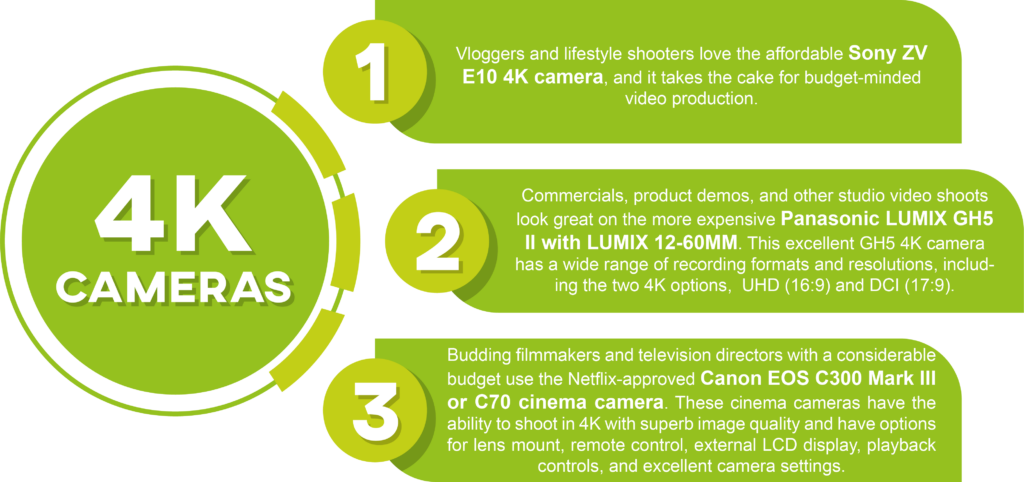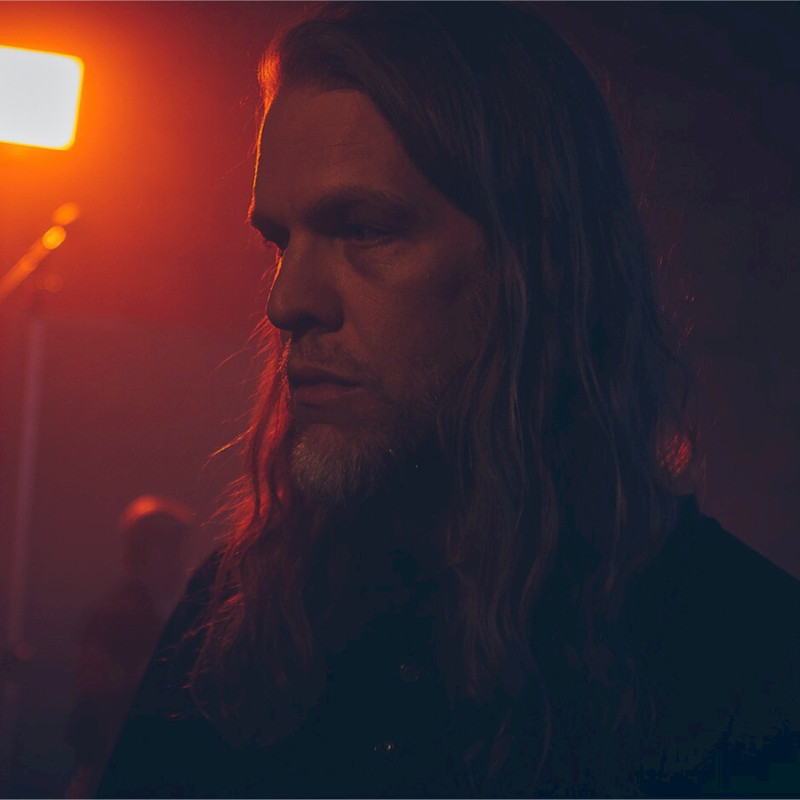4K video production is the emerging standard in high-resolution, cinematic video for film, and it’s a great way to future-proof your video content. Known as Ultra High Definition (UHD), 4K videos have a horizontal resolution of 3,840 pixels and a vertical resolution of 2,160 pixels for 8 million+ total pixels. With 4x the total pixels of a Full High Definition (Full HD) video and 8x the total pixels of High Definition (HD), digital cinema has already adopted 4K in a format called DCI (Digital Cinema Initiatives) that has a slightly wider resolution than UHD at 4096 x 2160 pixels.
Though HD and Full HD are still the standards for television, Blu-ray, and streaming channels like YouTube, 4K video production is growing in popularity because it offers directors and editors a capture that looks better, software-stable footage that makes post-production easier, and next-generation resolution to future-proof your videos well beyond 2024. Yes, you’ll need more storage for capture and a faster computer for editing, but storage is cheap, and we’ll show you some excellent and affordable options for choosing the right 4K camera, computer, and equipment. Before you’re done reading, charlieuniformtango will equip you with everything you need to know to make 4K videos.
What You Need For 4K Video Production
When it comes to 4K video production, the ultra-high resolution output comes at the cost of a good 4K camera, a solid-state storage drive, a fast computer with superior computer processing and memory, a workhorse GPU for optimal video editing, and efficient video editing software. Entry-level 4K video production equipment starts at $2,000–$3,000 all-in and scales up quickly. But before getting discouraged, remember, if you’re serious about your craft, client rates for 4K video content can gross as much as $750/hour. Bottom line: 4K video production moves from the accessible to the expensive as skill and equipment scale. The good news is that as you grow your talent with better equipment, you’ll also command higher returns on your investment.
Selecting the Right 4K Camera and Storage
4K Cameras
Getting started with 4K video production requires a 4K camera, but you knew that. What you may not know is that there are affordable options, alongside more expensive 4K cameras, to shoot and capture different types of footage.

Good
Sony ZV E10 4K camera
Vloggers and lifestyle shooters love the affordable Sony ZV E10 4K camera
Better
Panasonic LUMIX GH5 II with LUMIX 12-60MM
Commercials, product demos, and other studio video shoots look great on the more expensive Panasonic LUMIX GH5 II with LUMIX 12-60MM.
Best
Canon EOS C300 Mark III or C70 cinema camera
Budding filmmakers and television directors with a considerable budget use the Netflix-approved Canon EOS C300 Mark III or C70 cinema camera
Note: 4K Cameras require storage cards and only the U3 class is capable of writing at the speed required for 4K video. In general, more storage is better and 256 GB – 1 TB is ideal for longer shoots.
4K Video Storage
You’ll want a solid-state hard drive (SSD) for your 4K video storage. Solid-state hard drives are the next generation of hard disk drives (HDDs), and though they cost more, SSDs are faster and utilize less power with the absence of moving parts. For less than $200, you can get some of the best solid-state drives for video editing with 2TB of storage, allowing you to store up to 70 hours of 4K video footage. With 4K video, we suggest you err on the side of more storage than you think you need so you don’t have to worry about running out of space.
4K Computers, Monitors, Processing, Memory and Graphics Cards
If you’re just starting out in 4K editing, you’ll wonder if there’s an all-in-one computer that combines all the hardware elements you need to cut your teeth. The Microsoft Surface Studio 2 attempted to fill this hole in the market with entry-level 4K hardware and a beautiful touch-screen 4K monitor. And though 4K video creators loved many aspects of the Surface Studio, they did not love the outdated CPU, memory, and GPU (or the lack of inputs). That said, it is a simple option for 4K beginners.
One of the hard pills to swallow about 4K video editing is the expense and importance of assembling the best elements of 4K equipment to build your own workhorse computer. For example, consider that many computers do not have 4K monitors. Of course, you can edit 4K videos on non-4K computer monitors, but being able to see the final cutdown of your video on a 4K display is preferable. And here again, you’ll have to explore options that are applicable for your PC or Mac, from the affordable Dell S2722QC 27-inch 4K USB-C Monitor to the more expensive Apple Studio Display to the high-end Samsung Odyssey G9. And though you don’t have to break the bank on a 4K monitor, you’ll still want to stash some cash for your internal hardware components. The main considerations are a fast CPU, lots of memory for RAM, and high clock speeds for your graphics cards (GPUs). 4K video editing demands efficient processing speed and plenty of memory.
CPU for 4K Editing
4K video editing requires a CPU with a minimum of 6 cores, 12 threads, and a base clock speed of 3.7GHz. Some entry-level options for PC and MAC are the AMD Ryzen 5 5600X and the Intel Core i5-10600K. These CPUs can handle 4K video editing on a smaller budget. But as you scale up in power and pricing, the two best CPU options for 4K editing are the AMD Ryzen 9 7950X and the Intel Core i9-13900K. Though there are some differences in performance and pricing, both CPUs are excellent with 16 and 24 core processors, 32 threads, and maximum clock speeds of 5.7 and 5.8 GHz. Of course, you’ll still want to understand the best interplay between your choice of CPU and other hardware components.
How Much RAM for 4K Video Editing?
32GB of RAM is the minimum necessary for 4K video editing and encourages smooth playback, seamless editing, and faster rendering of video footage. That said, as your budget scales, and you’re doing more complex editing tasks, you’ll benefit from 64GB or more of RAM. When you’re working with multiple video and audio tracks, doing color grading, and using 3D and visual effects, 64GB greatly reduces rendering times and makes the editing process more fun.
Best GPU for 4K Video Production
If you’re editing 4K videos, spending money on a powerful Graphics Processing Unit (GPU) is essential. Your GPU is directly responsible for accelerating the speed of your graphics rendering and, by extension, is greatly responsible for the speed at which you can deliver a final cut. Professional video editors and post-production houses know the importance of investing in the best GPU for processing all sound and visual effects, 3D, animation, color correction and color grading, and graphics. Admittedly, this means there are fewer corners to cut for budget-friendly options. At the high-end the Nvidia RTX 4090 GPU sees significant improvement scores compared to earlier Nvidia RTX generations. The 4090 cannot be compared directly to the AMD Radeon RX 7900 XTX based on specs (or price), but it is also considered one of the best GPUs for mid-high to high-end performance. Whether you break the bank with the Nvidia RTX 4090, or save some money on the AMD Radeon RX 7900 XTX, you’ll be happy you’ve got an excellent GPU for 4K editing and post-production.
4K Video Editing Software
Believe it or not, one of the easiest decisions you’ll make is your 4K video editing software. That’s because the pricing for software ranges from free and accessible editing software like CapCut to very affordable and intricate editing software like Davinci Resolve or Adobe Premiere Pro. This leaves room for you to explore several options, and in fact, 4K video editors are generally familiar with several editing softwares for different disciplines of post-production, like sound editing. The good news is that similar functionality between video editing software will allow you to move from powerful free software, like Davinci Resolve, to more expensive paid software, like Premiere Pro. With that said, professional filmmakers edit video and visual effects with Premiere Pro, and it is considered the film industry standard.
